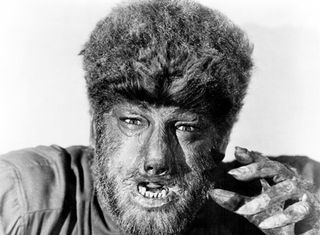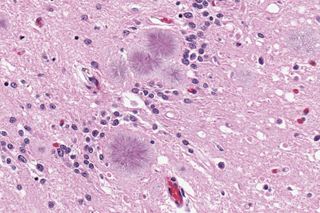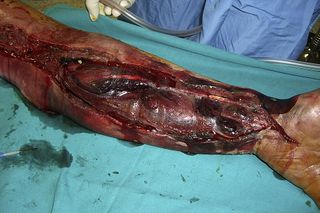10 Medical Conditions That Sound Fake but Are Actually Real

Werewolf Syndrome (also called Hypertrichosis, or Ambras Syndrome)

People who have the rare skin disease called Werewolf syndrome have some features that may resemble those of the mythical creatures for which the condition is named. According to the Genetic and Rare Diseases Information Center, the symptoms of Ambras syndrome, as the condition is also called, include excessive hair growth all over the body, except on the palms of the hands and soles of the feet. This includes fine hair on the face and ears.
The condition can also cause a person to have a triangular face, a bulbous nose and to lack teeth. Ambras syndrome is a genetic disease and is a dominant trait, and so if a child has one parent with this syndrome, the child may inherit it.
Facial Blindness (also called Prosopagnosia)

The word "prosopagnosia" comes from the Greek words "prósopo" meaning "face" and "agnōsia," which means "ignorance." Many of us forget names easily, but people with facial blindness may struggle to identify even familiar faces, or to tell people apart. There are varying degrees of the condition, and those with a severe form may be unable to distinguish between a face and another object, or to recognize their own face. [Here's a Giant List of the Strangest Medical Cases We've Covered]
Facial blindness is not related to general forgetfulness or memory loss. It can occur as the result of brain injury, neurodegenerative diseases, or stroke, according to the NINDS. There are also cases of congenital prosopagnosia, which means that people can be born with the disorder.
Sleeping Beauty Syndrome (also called Kleine-Levin Syndrome)

Like the long-unconscious princess, people with the neurological condition called Sleeping Beauty syndrome experience periods of excessive sleep. These episodes can last up to 20 hours a day, and bouts may go on for days, even weeks, according to the National Institute of Neurological Disorders and Stroke (NINDS). These episodes of lengthy sleep may be proceeded by flu-like symptoms and, when they're awake, people with this syndrome may exhibit various odd behaviors, including eating excessively, hallucinating or acting childishly.
But unlike the princess that the name conjures, 70 percent of the people who have this disorder are adolescent males, according to the NINDS. Stimulant medications are used to treat Kleine-Levin syndrome, and episodes tend to subside as a person reaches adulthood.
Mad Cow Disease (Bovine Spongiform Encephalopathy)

People cannot get mad cow disease; it is a disease that affects the brain and spinal cord of cows. It's called "mad cow" because it can cause infected cows to act violently or nervously, according to the U.S. Food and Drug Administration. The disease is properly called bovine spongiform encephalopathy, or BSE. But in the mid-1990s, a new disease was discovered that was related to mad cow, called variant Creutzfeldt-Jakob disease (vCJD). Like mad cow disease, vCJD is a fatal, degenerative brain disorder. And unlike other types of Creutzfeldt-Jakob disease, such as a familial form of the condition that is caused by a gene mutation and can be inherited, the variant form of CJD may be caused by eating food contaminated with the central nervous system tissue of a cow that was infected with BSE. NINDS notes that there is no direct proof of the relationship between eating beef from cattle with BSE and developing vCJD, but both that agency and the World Health Organization (WHO) say that evidence of the link between BSE and vCJD is strong.
Alien Hand Syndrome

Alien hand syndrome (AHS) is characterized by involuntary movements of a limb, usually the hand, that seem purposeful or functional. People with this movement disorder may also feel that the limb is not a part of their body.
Authors of a meta-analysis of research on AHS published in Tremor and Other Hyperkinetic Movements wrote, "Sometimes the limb is personified: patients have named their alien hands." Common causes of AHS include strokes, brain tumors and neurodegenerative illness. Treatments may involve Botox injections (which may temporarily weaken the muscles), cognitive behavioral therapy and distracting the affected hand by having it hold an object. As seen in the movie "Dr. Strangelove," there have been reports of people with this syndrome hitting or attempting to choke themselves. [7 Conditions That Botox May Help Treat]
Stone Man's Disease (also called Fibrodysplasia Ossificans Progressiva)

Stone man's disease is a disorder of the connective tissue where ligaments, tendons or skeletal muscles essentially turn into bone. People who have this condition, properly called fibrodysplasia ossificans progressiva (FOP), may be unable to move and can develop difficulty eating and breathing as their joints become locked in place.
The first symptom of this disorder that people usually develop is irregular big toes, which can occur at birth, according to the National Organization for Rare Disorders. Over time, FOP progresses, usually from the neck and shoulders downward, according to the U.S. National Library of Medicine. In people who have the disease, injuries to muscles or certain illnesses can trigger swelling and inflammation, which may then cause more tissues to turn to bone.
Imposter Syndrome

Imposter syndrome is not an official diagnosis, but was a term coined by psychologists Pauline Rose Clance and Suzanne Imes in 1978. In a paper published in the journal Psychotherapy Theory, Research and Practice,the researchers introduced this syndrome to the world, describing it as a feeling of ineptitude that occurs in highly successful women.
It has since been recognized that men may also have the condition, but it seems more common in women, according to the original research from Clance and Imes. People with this syndrome feel like they do not measure up to their achievements, and so they feel that they are "imposters" in their own lives. For example, they might believe that they got into a prestigious school through error or luck, or that their professional success is merely the result of others' overestimation of their abilities.
Walking Corpse Syndrome (also called The Cotard Delusion, or Cotard's Syndrome)

This neuropsychological disorder was first described in the 1880s by neurologist Jules Cotard. It involves a person believing that they are dead or soulless, or that parts of their body (which are intact) are missing, such as organs or blood.
One review of Cotard's syndrome found that it's often seen in patients who have severe depression. Cultural beliefs, such as folklore about creatures that take organs or cause deaths in ways that can't be perceived, may also contribute to this rare disorder. A report published in 2013 in the Iranian Journal of Psychiatry and Behavioral Sciencesdetails the case of a woman with postpartum depression who thought that she was dying, due to an attack by a Persian ghost, called an "Aal." People with this disorder may believe in their death so strongly that they starve themselves.
Flesh-Eating Bacteria (also called Necrotizing Fasciitis)

Flesh-eating bacteria is exactly what it sounds like, a bacterial skin infection that eats away at soft tissue called the fascia, which surround muscles, blood vessels, nerves and fat. It also damages tissue near the fascia. Many different bacteria can cause this infection, but Group A strep (Streptococcus) are the most common cause. The infection can spread quickly and be deadly but, if caught early, it can be treated with antibiotics and surgery.
Necrotizing fasciitis is rare, especially among healthy people, according to the Centers for Disease Control and Prevention. People looking to avoid it should practice proper wound care and stay away from hot tubs, swimming pools and natural bodies of water (like lakes, rivers and oceans) if they have an open wound or infection.
Alice in Wonderland Syndrome

Named in a 1955 Canadian Medical Association Journal(CMAJ) article, this syndrome is often associated with people who have migraine headaches and epilepsy. People with the condition may have distorted vision or perceptions that make it seem like parts of their body are much bigger or smaller than expected, or that one body part is taller or shorter than they are in reality.
The CMAJ article also says the name was chosen because Carroll experienced migraines. This syndrome may also be caused by viral infection or drug use.
Original article on Live Science.
Sign up for the Live Science daily newsletter now
Get the world’s most fascinating discoveries delivered straight to your inbox.
